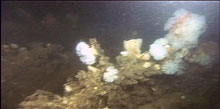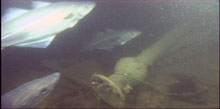
The ROV got close enough to image the multiple flanges of a Portland paddlewheel, now covered with benthic marine life. Image courtesy NOAA/NURC-UConn/The Science Channel. Click image for larger view.
2003 Portland Mission Summary
Ben Cowie-Haskell
Operations Coordinator
Stellwagen Bank National Marine Sanctuary
Principal Investigator, Portland Expedition
My "punchlist" of objectives for this mission is complete, save for one item. This is an amazing accomplishment considering the odds we were up against.
First, we started the mission with a completely untested, brand-new ROV (remotely operated vehicle) system. After two days of troubleshooting, the technicians got it running and it ran well for the remainder of the cruise.
Second, Mother Nature presented a major challenge in the form of Hurricane Isabel. She could have easily wiped out the entire mission, but instead stole only two days from us at the end.
Thus, we accomplished a great deal during our five days of actual research time. This was due to several factors: good weather, cooperating technology, an excellent research platform (RV Connecticut) and its crew, an excellent science crew, and advance reconnaissance of study sites.

This is the second steam release pipe from the steam engine we found. The first one was found last year in the sand off the ship's portside. The steam release pipe is often called a "spittoon" because it is similar to one in shape. It was connected to the steam chest on the engine and ran to the top of the hurricane deck roof. Its function was to release excess steam pressure. Image courtesy NOAA/NURC-UConn/The Science Channel. Click image for larger view.
Our primary objective was to document the steamship Portland and to conduct a video mosaic of all or part of the hull. Given the entanglement risk, we documented about as much of the wreck as we could. This included the bow, the forward deck, the forward starboard and portsides, the twin chimneys, the walking beam and upper A-frame, the port paddlewheel flange, the starboard kitchen and storeroom areas, and the aft deck and ladies’ cabin area below decks. These video data, along with the data we collected last year, give us about 60 percent coverage of the exterior of the wreck.
We did not obtain a video mosaic of the hull because of poor visibility and high entanglement risk. Therefore, we were not able to obtain accurate measurements of the hull. This would have helped us to assess deterioration of the hull over time.
Some of the new things we learned this year are that the starboard side amidships appears to be collapsed; many artifacts exist in the kitchen/storeroom area, and we observed two distinct types of ceramic ware -- fine china and a heavier, yellow-glazed “mug”; the bow is intact; the smokestacks are absent, with only chimneys remaining; there is a large opening in aft deck (caused by deterioration) leading to the ladies’ cabin area; and the deck is extremely fragile.
Why the Portland lost power and foundered will remain a mystery until we can return for a better look at the connecting rod and the engine room and boilers. We'd like to determine what was being used as fuel in the ship's firebox -- it might help us better understand why the Portland foundered. Getting a peek into the firebox and engine room will take some pretty advanced technology, however, such as expendable mini-ROVs or real-time autonomous underwater vehicles. We will tackle these challenges in the coming years.
Our secondary objective was to document the wrecks of the schooners Louise B. Crary and Frank A. Palmer. Our goal proved elusive due to the extreme entanglement hazard presented by both wrecks. Not only are they draped with ghost fishing nets, other nets actually prevented us from approaching the Palmer. We got a 60 percent view of the Crary’s portside before giving up and moving on to a nearby unidentified 60-ft wreck.
On a previous sidescan sonar cruise courtesy of Garry Kozak of Klein Sonar Associates, we came across this wreck that lies some 2,000 ft away from the Portland. So we gave up on the Crary and Palmer and investigated the 60-footer. Turns out it was an eastern-rigged trawler (as I had surmised based on the sidescan signature) sitting upright on the sea floor with deck and wheelhouse intact. We obtained some stunning video footage of the entirety of this small wreck, including the steering wheel in the wheelhouse.

Exploration of the unknown 60-ft fishing vessel revealed an open door to the pilothouse and a view of the steering wheel. Image courtesy NOAA/NURC-UConn/The Science Channel.Click image for larger view.
We tried to squeeze in one more dive on a mystery wreck on the Thursday morning before Isabel let herself be known in the offshore waters. We dove on a unidentified wreck several miles north of the Portland. We found the wreck immediately after landing on the sea floor. Water clarity was greater than 30 ft, which was fantastic compared to previous days. The coal surrounding the wreck and in the hold told us this was a coal schooner. The ship was about 100 ft long and we were documented about 80 percent of the hull. The decks are largely deteriorated, but the frames are mostly intact and upright. The bow and stern are intact. Knees for the deck are strewn everywhere; hence, we named it the "Knee Wreck." We documented the captain’s quarters, where we found a mechanical log, meerschaum smoking pipes, bottles, clockworks, and other unidentified artifacts. A porcelain washbasin with a faucet was found off the aft quarter. We will try to date the vessel based on some of these artifacts.
In summary, we learned a great deal more about the richness of the repository of shipwrecks in the Stellwagen Bank National Marine Sanctuary ![]() . Nevertheless, much work remains to be done!
. Nevertheless, much work remains to be done!

















